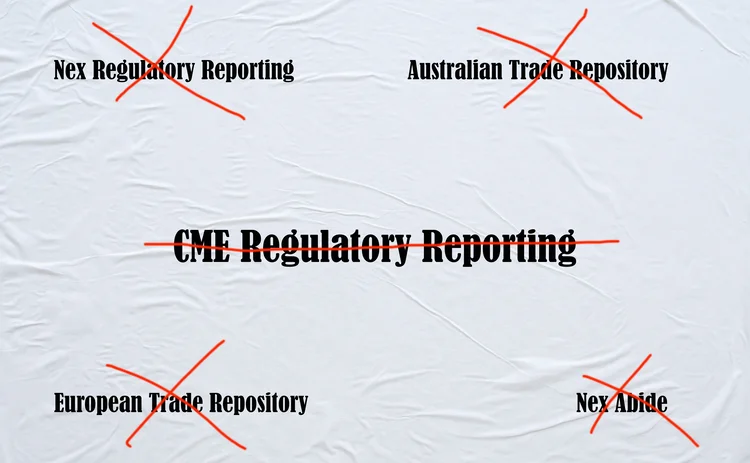CME Reg Reporting Competitors Vie to Fill the Void Ahead of Withdrawal
With over five months to go until CME unwinds its regulatory reporting businesses, competing firms are pushing to fill the service gaps and grab a slice of the market share.

In mid-May, news broke that CME Group would scale back its regulatory reporting businesses, including NEX Regulatory Reporting (NRR), NEX Abide, and its European and Australian trade repositories (TRs).
The reporting units covered several global reporting regimes, such as the European Market Infrastructure Regulation (Emir), the latest Markets in Financial Instruments Directive (Mifid II), the Markets in Financial Instruments Regulation (Mifir), the Securities Financing Transactions Regulation
Only users who have a paid subscription or are part of a corporate subscription are able to print or copy content.
To access these options, along with all other subscription benefits, please contact info@waterstechnology.com or view our subscription options here: http://subscriptions.waterstechnology.com/subscribe
You are currently unable to print this content. Please contact info@waterstechnology.com to find out more.
You are currently unable to copy this content. Please contact info@waterstechnology.com to find out more.
Copyright Infopro Digital Limited. All rights reserved.
As outlined in our terms and conditions, https://www.infopro-digital.com/terms-and-conditions/subscriptions/ (point 2.4), printing is limited to a single copy.
If you would like to purchase additional rights please email info@waterstechnology.com
Copyright Infopro Digital Limited. All rights reserved.
You may share this content using our article tools. As outlined in our terms and conditions, https://www.infopro-digital.com/terms-and-conditions/subscriptions/ (clause 2.4), an Authorised User may only make one copy of the materials for their own personal use. You must also comply with the restrictions in clause 2.5.
If you would like to purchase additional rights please email info@waterstechnology.com
More on Regulation
In 2025, keep reference data weird
The SEC, ESMA, CFTC and other acronyms provided the drama in reference data this year, including in crypto.
Waters Wavelength Ep. 299: ACA Group’s Carlo di Florio
Carlo di Florio joins the podcast to discuss regulations.
IEX, MEMX spar over new exchange’s now-approved infrastructure model
As more exchanges look to operate around-the-clock venues, the disagreement has put the practices of market tech infrastructure providers under a microscope.
FCA to publish bond tape tender details by end of January
Market participants must wait a month longer than expected for the regulator’s draft tender document, which will see several bidders vie for the chance to build the UK’s long-awaited consolidated tape for bonds.
Too ’Berg to fail? What October’s Instant Bloomberg outage means for the industry
The ubiquitous communications platform is vital for traders around the globe, especially in fixed income and exotic derivatives. When it fails, the disruption can be great.
New data granularity rules create opportunities for regtech providers
As evidence, Regnology increased its presence in North America with the addition of Vermeg's Agile business—its 8th acquisition in three years—following a period of constriction and consolidation in the market.
Bond tape hopefuls size up commercial risks as FCA finalizes tender
Consolidated tape bidders say the UK regulator is set to imminently publish crucial final details around technical specifications and data licensing arrangements for the finished infrastructure.
The Waters Cooler: A little crime never hurt nobody
Do you guys remember that 2006 Pitchfork review of Shine On by Jet?







